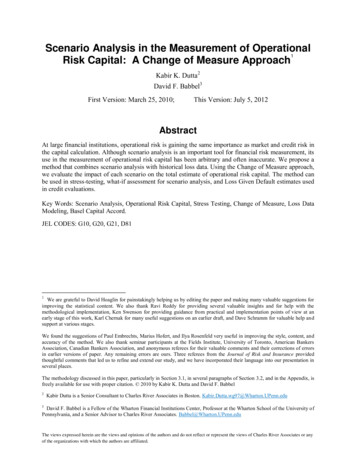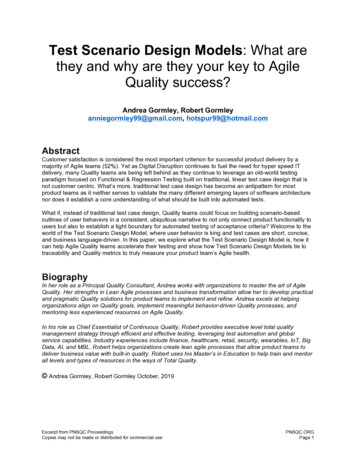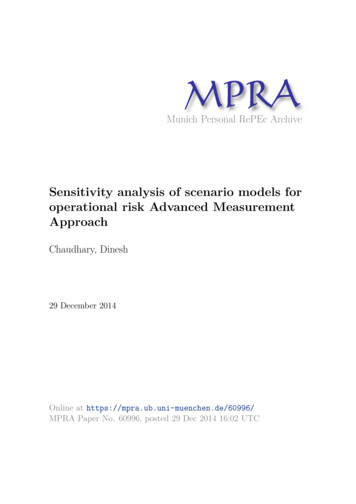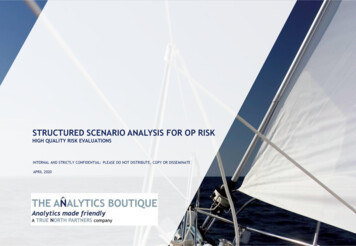
Transcription
Scenario Analysis in the Measurement of Operational1Risk Capital: A Change of Measure ApproachKabir K. Dutta2David F. Babbel3First Version: March 25, 2010;This Version: July 5, 2012AbstractAt large financial institutions, operational risk is gaining the same importance as market and credit risk inthe capital calculation. Although scenario analysis is an important tool for financial risk measurement, itsuse in the measurement of operational risk capital has been arbitrary and often inaccurate. We propose amethod that combines scenario analysis with historical loss data. Using the Change of Measure approach,we evaluate the impact of each scenario on the total estimate of operational risk capital. The method canbe used in stress-testing, what-if assessment for scenario analysis, and Loss Given Default estimates usedin credit evaluations.Key Words: Scenario Analysis, Operational Risk Capital, Stress Testing, Change of Measure, Loss DataModeling, Basel Capital Accord.JEL CODES: G10, G20, G21, D811We are grateful to David Hoaglin for painstakingly helping us by editing the paper and making many valuable suggestions forimproving the statistical content. We also thank Ravi Reddy for providing several valuable insights and for help with themethodological implementation, Ken Swenson for providing guidance from practical and implementation points of view at anearly stage of this work, Karl Chernak for many useful suggestions on an earlier draft, and Dave Schramm for valuable help andsupport at various stages.We found the suggestions of Paul Embrechts, Marius Hofert, and Ilya Rosenfeld very useful in improving the style, content, andaccuracy of the method. We also thank seminar participants at the Fields Institute, University of Toronto, American BankersAssociation, Canadian Bankers Association, and anonymous referees for their valuable comments and their corrections of errorsin earlier versions of paper. Any remaining errors are ours. Three referees from the Journal of Risk and Insurance providedthoughtful comments that led us to refine and extend our study, and we have incorporated their language into our presentation inseveral places.The methodology discussed in this paper, particularly in Section 3.1, in several paragraphs of Section 3.2, and in the Appendix, isfreely available for use with proper citation. 2010 by Kabir K. Dutta and David F. Babbel2Kabir Dutta is a Senior Consultant to Charles River Associates in Boston. Kabir.Dutta.wg97@Wharton.UPenn.edu3David F. Babbel is a Fellow of the Wharton Financial Institutions Center, Professor at the Wharton School of the University ofPennsylvania, and a Senior Advisor to Charles River Associates. Babbel@Wharton.UPenn.eduThe views expressed herein are the views and opinions of the authors and do not reflect or represent the views of Charles River Associates or anyof the organizations with which the authors are affiliated.
IntroductionScenario analysis is an important tool in decision making. It has been used for several decades in variousdisciplines, including management, engineering, defense, medicine, finance and economics. Mulvey andErkan (2003) illustrate modeling of scenario data for risk management of a property/casualty insurancecompany. When properly and systematically used, scenario analysis can reveal many important aspects ofa situation that would otherwise be missed. Given the current state of an entity, it tries to navigatesituations and events that could impact important characteristics of the entity in the future. Thus, scenarioanalysis has two important elements:1. Evaluation of future possibilities (future states) with respect to a certain characteristic.2. Present knowledge (current states) of that characteristic for the entity.Scenarios must pertain to a meaningful duration of time, for the passage of time will make the scenariosobsolete. Also, the current state of an entity and the environment in which it operates give rise to variouspossibilities in the future.In management of market risk, scenarios also play an important role. Many scenarios on the future stateof an asset are actively traded in the market, and could be used for risk management. Derivatives such ascall (or put) options on asset prices are linked to its possible future price. Suppose, for example, thatCisco (CSCO) is trading today at 23 in the spot (NASDAQ) market. In the option market we find manydifferent prices available as future possibilities. Each of these is a scenario for the future state of CSCO.The price for each option reflects the probability that the market attaches to CSCO attaining more (orless) than a particular price on (or before) a certain date in the future. As the market obtains moreinformation, prices of derivatives change, and our knowledge of the future state expands. In the languageof asset pricing, more information on the future state is revealed.At one time, any risk for a financial institution that was not a market or credit risk was considered anoperational risk. This definition of operational risk made data collection and measurement of operationalrisk intractable. To make it useful for measurement and management, Basel banking regulation narrowedthe scope and definition of operational risk. Under this definition, operational risk is the risk of loss,whether direct or indirect, to which the Bank is exposed because of inadequate or failed internal processesor systems, human error, or external events. Operational risk includes legal and regulatory risk, businessprocess and change risk, fiduciary or disclosure breaches, technology failure, financial crime, andenvironmental risk. It exists in some form in every business and function. Operational risk can cause notonly financial loss, but also regulatory damage to the business’ reputation, assets and shareholder value.One may argue that at the core of most of the financial risk one may be able to observe an operationalrisk. The Financial Crisis Inquiry Commission Report (2011) identifies many of the risks defined underoperational risk as among the reasons for the recent financial meltdown. Therefore, it is an importantfinancial risk to consider along with the market and credit risk. By measuring it properly an institutionwill be able to manage and mitigate the risk. Financial institutions safeguard against operational riskexposure by holding capital based on the measurement of operational risk.Sometimes a financial institution may not experience operational losses that its peer institutions haveexperienced. At other times, an institution may have been lucky. In spite of a gap in its risk it didn’texperience a loss. In addition, an institution may also be exposed to some inherent operational risks thatcan result in a significant loss. All such risk exposures can be better measured and managed through acomprehensive scenario analysis. Therefore, scenario analysis should play an important role in themeasurement of operational risk. Banking regulatory requirements stress the need to use scenario analysis1
in the determination of operational risk capital.4 Early on, many financial institutions subjected to bankingregulatory requirements adopted scenario analysis as a prime component of their operational risk capitalcalculations. They allocated substantial time and resources to that effort. However, they soon encounteredmany roadblocks. Notable among them was the inability to use scenario data as a direct input in theinternal data-driven model for operational risk capital. Expressing scenarios in quantitative form andcombining their information with internal loss data poses several challenges. Many attempts in thatdirection failed miserably, as the combined effect produced unrealistic capital numbers (e.g., 1,000 timesthe total value of the firm). Such outcomes were typical. As a result, bank regulators relaxed some of therequirements for direct use of scenario data. Instead, they suggested using external loss data to replacescenario data as a direct input to the model. External loss events are historical losses that have occurred inother institutions. Such losses are often very different from the loss experience of the institution. In ouropinion, that process reduced the importance of scenarios in measuring operational risk capital.Previously, as well as in current practice, external loss data were and are used in generating scenarios.We believe that the attempts to use scenario data directly in capital models have failed because of incorrect interpretation and implementation of such data. This work attempts to address and resolve suchproblems. Because scenarios have been used successfully in many other disciplines, we think thatscenario data should be as important as any other data that an institution may consider for its riskassessments. Some may question, justifiably, the quality of scenario data and whether such data can bebelievable. We contend that every discipline faces such challenges. As we will show, the value inscenario data outweighs the inherent weaknesses it may have. Also, through systematic use we will beable to enhance the quality of the data.In this paper we propose a method that combines scenario analysis with historical loss data. Using theChange of Measure approach, we evaluate the impact of each scenario on the total estimate of operationalrisk capital. Our proposed methodology overcomes the aforementioned obstacles and offers considerableflexibility. The major contribution of this work, in our opinion, is in the meaningful interpretation ofscenario data, consistent with the loss experience of an institution, with regard to both the frequency andseverity of the loss. Using this interpretation, we show how one can effectively use scenario data, togetherwith historical data, to measure operational risk exposure and, using the Change of Measure concept,evaluate each scenario’s effect on operational risk. We believe ours is the first systematic study of theproblem of using scenario data in operational risk measurement.In the next section we discuss why some of the earlier attempts at interpreting scenario data did not succeed and the weaknesses of current practices. We then discuss the nature and type of scenario data that weuse in our models. Following that, we discuss our method of modeling scenario data and economicevaluation of a set of scenarios in operational risk measurement. We conclude with a discussion of someissues that may arise in implementing the method and of its use in other domains.1. Problem DescriptionIn their model for calculating operational risk capital, financial institutions subject to Basel bankingregulations are required to use, directly or indirectly, four data elements: internal loss data (ILD), which are collected over a period of time and represent actual lossessuffered by the institution;4A basic source on these requirements is Risk-Based Capital Standards: Advanced Capital Adequacy Framework — Basel II pdf)2
external loss data (ELD), which are loss events that have occurred at other institutions and areprovided to the institution via a third-party vendor or from a data consortium;scenario data based on assessments of losses the institution may experience in the future; andbusiness environment score, created from a qualitative assessment of the business environmentand internal control factors (BEICF).The regulatory rule does not prescribe how these elements should be used. However, given the similarityof operational losses to property/casualty losses, the measurement approach predominantly follows theloss distribution approach (LDA), which actuaries use for pricing property/casualty insurance.Unit of measure is the level or degree of granularity at which an institution calculates its operational riskcapital. The least granular unit of measure is enterprise-wide. More commonly, institutions calculateoperational risk capital for several units of measure and aggregate those capital estimates. Units ofmeasure are often determined by business line or type of loss event. Smaller business lines and/or lesscommon types of loss events are frequently combined to create one unit of measure.Of the four data elements, internal loss data are used primarily in the Loss Distribution Approach (LDA)to arrive at a base model. In that approach, one tries to fit two distributions: the severity distribution,which is derived from the amounts of all the losses experienced by the institution; and the frequency distribution, which is derived from the number of losses that have occurred at the institution over a predetermined time period (usually one year). As the frequency distribution, the Poisson distribution is thechoice of nearly all financial institutions. Generally, the Poisson parameter is the average number oflosses on an annual basis. A loss event (also known as the loss severity) is an incident for which an entitysuffers damages that can be assigned a monetary value. The aggregate loss over a specified period of time , where is a random observation from the frequency distribution,is expressed as the sumand each is a random observation from the severity distribution. We assume that the individual lossesare independent and identically distributed, and each is independent of . The distribution ofiscalled the aggregate loss distribution. The risk exposure can be measured as a quantile of. Dutta andPerry (2007) discuss the use and various challenges in modeling the severity distribution using internalloss data.Given the characteristics and challenges of the data, an LDA approach resolves many issues. The sum LTotcan be calculated by either Fourier or Laplace transforms as suggested in Klugman et al. (2004), byMonte Carlo simulation, or by an analytical approximation. We use the simulation method as well as ananalytical approximation.Regulatory or economic capital for the operational risk exposure of an institution is typically defined asthe 99.9th or 99.97th percentile of the aggregate loss distribution. Alternatively, we can call it capital orprice for the risk.51.1 Scenarios Are Not Internal Loss DataMany financial institutions have been collecting internal loss data for several years. These data can beconsidered the current state for operational risk exposure. Additionally, many losses of various types andmagnitudes have occurred only at other financial institutions. A financial institution may choose toevaluate such external loss data in order to understand the potential impact of such losses on its own riskprofile. Typically, an institution analyzes those losses based on the appropriate magnitude and probabilityof occurrence, given the current state of its risk profile, and develops a set of scenarios.5See footnote 4 for source.3
Suppose institution A observes that institution B has incurred a 50 million loss due to external fraud, atype of operational loss. Institution A is also aware of the circumstances under which that loss occurred.After evaluating its own circumstances (current state), institution A determines that it is likely toexperience a similar event once every ten years and that such an event would result in a 20 million loss.These are the frequency and severity of an event in the future state. Alternatively, the institution couldspecify a range, such as 15 million to 25 million, instead of a single number. We discuss this issuefurther in Section 2. Together with the description of the loss event, the specified severity and frequencyconstitute a scenario.Suppose an institution has collected internal loss data for the last five years. It also generates a scenariofor a certain operational loss event whose likelihood of occurring is once in ten years, resulting in a 20million loss. It is inaccurate to interpret this as just another data point that could be added to the internalloss data. Doing so would change the scenario’s frequency to once in five years from once in ten years.This key insight led us to develop a method that appropriately integrates scenario data with internal lossdata. The problem most often reported from integrating scenario data with internal loss data isunrealistically large capital estimates. Because the integration process failed to consider the frequenciesspecified for the scenarios, the adverse scenarios were analyzed with inflated frequencies. A scenariocould also be incorrectly analyzed with a frequency lower than specified. If the 20 million loss couldoccur once in 2.5 years, adding it to internal loss data from five years would dilute the effect of thescenario. A simplistic remedy would approximate the intended effect of this scenario by adding two suchlosses to the five years of internal data. Thus, frequency plays a key role in interpreting scenarios acrossfinancial institutions.Suppose that, for the same unit of measure, two institutions have the same scenario of a 20 million lossoccurring once in 10 years. One institution has an average of 20 losses per year, and the other has 50. Forthe institution with 20 losses per year, the scenario has much more impact than for the institution with 50losses per year. Our method properly aligns the frequency of the scenario data with the time horizon ofinternal loss experience.Continuing with the example of a 20 million loss whose frequency is once in ten years, in order to mergethis scenario with internal loss data from five years’ experience, we will have to consistently recreateinternal data with a sample size equivalent to a period of ten years. Only then can we merge the scenario’s 20 million loss with the internal data, and we would do so only if such a loss has not already beenobserved with sufficient frequency in those data. In other words, we use the current state of five years ofobserved internal loss data to generate enough data to determine whether the loss amount in the scenariois represented with sufficient frequency in the current severity distribution.1.2 Measurement Practices Using Scenario DataRosengren (2006) adequately captured and summarized the problems with and the art of using scenarioanalysis for operational risk assessment. The issues discussed in Rosengren (2006) are still valid. In fact,since then, there has been very little, if any, focus on the development of scenario-based methodology foroperational risk assessment. One exception was Lambrigger et al. (2007), who made an early attempt tocombine expert judgment with internal and external operational loss data. Their informal approach was tomake qualitative adjustments in the loss distribution using expert opinion, but they provided no formalmodel for incorporating scenarios with internal and external loss data. The methods that we found in theliterature are very ad hoc, and most integrate scenarios and internal or external data without soundjustifications.4
One method6 pools the severities from all the scenarios and then samples from that pool a severity foreach unit of measure that the institution is using for internal or external loss data modeling. In eachreplication of the simulation, the severities are sampled according to the probabilities assigned to thescenarios for that unit of measure. If a severity is chosen, it is added to other severities chosen in thatreplication. If no severity is chosen, zero is added. From the observed distribution of the summed severityamounts (over the trials), the 99.9th or 99.97th percentile is chosen. This number is then compared withthe corresponding percentile of the loss distribution obtained using internal or external loss data, and theinstitution must decide which number to use for regulatory capital. Typically the scenario-based numberwill be much higher than the number based on internal or external data. In such situations, a numberbetween the two is chosen as the 99.9th or 99.97th percentile. Rarely, the scenario-based 99.9% or99.97% level number would be added to the corresponding number obtained using internal or externalloss data to provide an estimate of extreme loss. This method suffers from the drawback that the universeof potential severe loss amounts is limited to the severity values assigned to the scenarios, which arecompletely isolated from internal and external loss data. This approach closely resembles sampling froman empirical distribution. Dutta and Perry (2007) highlight some of the problems involved.Another method derives two types of severity numbers from the one scenario created per unit of measure.One figure is the most likely severity outcome for the scenario, and the other represents the worst severityoutcome. Then a purely qualitative judgment is made to interpret these two severity values. The worstcase severity outcome is put at the 99th percentile (or higher) of the severity distribution obtained frominternal or external data for that unit of measure, and the most likely severity outcome is put at the 50thpercentile of the severity distribution. The 99.9th or 99.97th percentile is obtained from the lossdistribution after recalibrating the severity distribution with these two numbers. As in the previousmethod, the resulting percentile is compared with the corresponding percentile of the distribution basedon internal or external loss data. Typically the institution uses purely qualitative judgment to choose anoperational risk capital amount between the two figures.All other methods of which we are aware are variations or combinations of these two. Institutions adoptsome type of ad hoc, often arbitrary, weighting of the 99.9th or 99.97th percentiles from the lossdistributions derived from both internal loss event data (sometimes also including external loss eventdata) and the scenario data to arrive at a final model-based regulatory or economic capital number.2. Generating Scenario DataExternal loss data are the primary basis for scenario generation at every financial institution. Severalsources offer external data.7 Those data contain the magnitude of the loss amount and a description of theloss, including the name of the institution, the business line where the loss happened, and the loss type.Basel regulatory requirements categorize operational losses into seven types: Internal Fraud, ExternalFraud, Employment Practices and Work Place Safety, Client Products and Business Practices, Damage toPhysical Assets, Business Disruptions and System Failures, and Execution Delivery and ProcessManagement.Prior to generation of scenarios, risk management decisions determine the unit of measure, which oftencrosses loss types or loss types within business lines. It could also cross business lines or sub-businesslines. For some units of measure, internal loss experience may not be adequate to support any meaningfulanalysis. Some financial institutions supplement such units of measure with external data. From6The methods described are not published but observed in practice. Financial institutions have implemented similar methods.The First database from Fitch is one good source of data. It is based upon publicly available information on operational losseswith severities exceeding 1 million that have occurred at financial institutions.75
preliminary research we have undertaken on external data, we are not comfortable using our approach onunits of measure that have insufficient internal loss data to develop a meaningful and stable model.Although our method does not explicitly depend on which data are used for calibration, an unstable basemodel will give poor estimates of the effects of scenarios. Thus, we often form an “other” category thatincludes adequate internal loss data.To generate scenarios within a unit of measure, an institution uses a scenario workshop, typicallyconducted by a corporate risk manager or an independent facilitator. The participants are business linemanagers, business risk managers, and people with significant knowledge and understanding of theirbusiness and the environments in which it operates. Workshop participants discuss the businessenvironments and current business practices, and take guidance and help from external data such as thefollowing:Event AAt bank XYZ, when selling convertibles to clients, an employee makes inappropriate promises to buy themback at a certain price. Market conditions move in the wrong direction, and the bank is required to honorthe commitment. As result, the bank suffers a loss of 200,000,000.8Question for Workshop: Could a similar situation occur at our institution? If so, what is the potentialmagnitude of the loss, and how frequently might this happen?The unit of measure for this event will usually be Client Products and Business Practices (CPBP). Afterconsidering a range of possibilities, participants agree on a scenario related to this event. We are assumingone scenario per incident type. Multiple scenarios should be carefully combined without sacrificing theirvalue.The unit of measure such as CPBP can be thought of as a process driven by many factors, such asunauthorized employee practices in selling convertibles. A scenario is not loss data. It is an impact andsensitivity study of the current risk management environment. The data in a scenario have twoquantitative components – severity and frequency – and one descriptive component – the type of losswithin the unit of measure. The description identifies the type of scenario within a process and is anessential characteristic of a scenario. In the above example, the scenario is for unauthorized employeepractices of selling convertibles within CPBP. Often more scenarios are generated in a workshop than willbe useful for quantification. In that situation scenarios may be filtered, taking into account theirdescriptive components. This decision is best made at the scenario generation workshop. In the aboveexample the risk management team should very carefully decide whether a scenario on unauthorizedemployee practices for selling equity can be ignored when a scenario of unauthorized employee practicesfor selling convertibles was also generated, even though both are “unauthorized employee practices”within the larger event class of CPBP.The severity in a scenario can be a point estimate (e.g., 2 million) or a range estimate (e.g., between 1million and 3 million). We prefer to work with range estimates, intervals of the form [a, b], as webelieve that in such a hypothetical situation a range captures the uncertainty of a potential loss amount.This choice is consistent with the continuous distributions we use for modeling the severity of internalloss data. A continuous distribution assigns positive probability to ranges of values, but zero probabilityto any individual value. We can convert a point estimate to a range estimate by setting the lower andupper bounds of the range at appropriate percentages of the point estimate. We revisit this choice inSection 4.8This example was supplied to us by a banking associate. Our understanding is that it is an adaptation of an event from an external database.6
The frequency in a scenario takes the form, where m is the number of times the event is expectedto occur in years. We interpret as the number of events that we expect to occur in a sample of size n1 nt, where ni is the number of losses observed annually, sampled from the frequency distribution ofthe internal loss data for that particular unit of measure. We assume that the capital calculation is on anannual basis. Stating the frequency denominator as a number of years allows us to express the sample sizeas a multiple of the annual count of internal losses at an institution. Like the severity, the frequency could[]. For a range we interpret m t1 as the worst-case estimatetake the form of a range such asand m t2 as the best-case estimate. Alternatively, one could take a number between and , such astheir average. We are making a subtle assumption that we use throughout the analysis.Assumption 1: During a short and reasonably specified period of time, such as one year or less, the frequency and severity distributions based on the internal loss data for a unit of measure do not change.This assumption is important because our methodology is conditional on the given severity andfrequency distributions (in this case, based on internal loss data). Justification for the one-year timethreshold lies in the loss data collection process and capital holding period at major financial institutionsin the USA. To interpret the assumption in terms of time and state of riskiness of the unit of measure, wewould say that at time zero (today) we have full knowledge of the loss events for the unit of measure.Using this knowledge, we forecast the future for a reasonable period of time in which we can safelyassume that the assumption is valid. We stress that scenario data are not the institution’s loss experience.Our analysis does not use scenario data as a substitute for internal loss data. Scenario data represent thepossibility of a loss; we are proposing a method to study its impact. Therefore, we make another vitalassumption.Assumption 2: The number of scenarios generated for a unit of measure is not more than the number ofinternal loss events observed in that unit of measure.Subjectivity and possible biases will always be inherent characteristics of scenario data. Methods for interpreting scenarios must take these features into account. As Kahneman, Slovic, and Tversky (1982) putit: “A scenario is especially satisfying when the path that leads from the initial to terminal state is notimmediately apparent, so that the introduction of intermediate stages actually raises the subjectiveprobability of the target event.” We have undertaken research that seeks to explain how one could controland reduce the biases and subjectivity in scenario data in the context of operational risk. Very preliminaryresults show that scenario data generated in the format discussed above are less subjective and thereforemore
At large financial institutions, operational risk is gaining the same importance as market and credit risk in the capital calculation. Although scenario analysis is an important tool for financial risk measurement, its use in the measurement of operational risk capital has been arbitrary and often inaccurate. We propose a method that combines .










